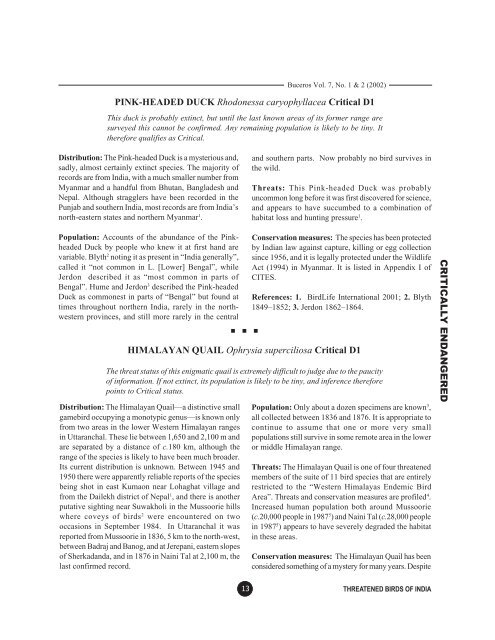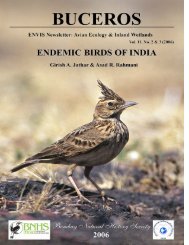Untitled - ENVIS Centre on Avian Ecology
Untitled - ENVIS Centre on Avian Ecology
Untitled - ENVIS Centre on Avian Ecology
You also want an ePaper? Increase the reach of your titles
YUMPU automatically turns print PDFs into web optimized ePapers that Google loves.
Buceros Vol. 7, No. 1 & 2 (2002)<br />
PINK-HEADED DUCK Rhod<strong>on</strong>essa caryophyllacea Critical D1<br />
This duck is probably extinct, but until the last known areas of its former range are<br />
surveyed this cannot be c<strong>on</strong>firmed. Any remaining populati<strong>on</strong> is likely to be tiny. It<br />
therefore qualifies as Critical.<br />
Distributi<strong>on</strong>: The Pink-headed Duck is a mysterious and,<br />
sadly, almost certainly extinct species. The majority of<br />
records are from India, with a much smaller number from<br />
Myanmar and a handful from Bhutan, Bangladesh and<br />
Nepal. Although stragglers have been recorded in the<br />
Punjab and southern India, most records are from India’s<br />
north-eastern states and northern Myanmar 1 .<br />
Populati<strong>on</strong>: Accounts of the abundance of the Pinkheaded<br />
Duck by people who knew it at first hand are<br />
variable. Blyth 2 noting it as present in “India generally”,<br />
called it “not comm<strong>on</strong> in L. [Lower] Bengal”, while<br />
Jerd<strong>on</strong> described it as “most comm<strong>on</strong> in parts of<br />
Bengal”. Hume and Jerd<strong>on</strong> 3 described the Pink-headed<br />
Duck as comm<strong>on</strong>est in parts of “Bengal” but found at<br />
times throughout northern India, rarely in the northwestern<br />
provinces, and still more rarely in the central<br />
n n n<br />
and southern parts. Now probably no bird survives in<br />
the wild.<br />
Threats: This Pink-headed Duck was probably<br />
uncomm<strong>on</strong> l<strong>on</strong>g before it was first discovered for science,<br />
and appears to have succumbed to a combinati<strong>on</strong> of<br />
habitat loss and hunting pressure 1 .<br />
C<strong>on</strong>servati<strong>on</strong> measures: The species has been protected<br />
by Indian law against capture, killing or egg collecti<strong>on</strong><br />
since 1956, and it is legally protected under the Wildlife<br />
Act (1994) in Myanmar. It is listed in Appendix I of<br />
CITES.<br />
References: 1. BirdLife Internati<strong>on</strong>al 2001; 2. Blyth<br />
1849–1852; 3. Jerd<strong>on</strong> 1862–1864.<br />
HIMALAYAN QUAIL Ophrysia superciliosa Critical D1<br />
The threat status of this enigmatic quail is extremely difficult to judge due to the paucity<br />
of informati<strong>on</strong>. If not extinct, its populati<strong>on</strong> is likely to be tiny, and inference therefore<br />
points to Critical status.<br />
Distributi<strong>on</strong>: The Himalayan Quail—a distinctive small<br />
gamebird occupying a m<strong>on</strong>otypic genus—is known <strong>on</strong>ly<br />
from two areas in the lower Western Himalayan ranges<br />
in Uttaranchal. These lie between 1,650 and 2,100 m and<br />
are separated by a distance of c.180 km, although the<br />
range of the species is likely to have been much broader.<br />
Its current distributi<strong>on</strong> is unknown. Between 1945 and<br />
1950 there were apparently reliable reports of the species<br />
being shot in east Kuma<strong>on</strong> near Lohaghat village and<br />
from the Dailekh district of Nepal 1 , and there is another<br />
putative sighting near Suwakholi in the Mussoorie hills<br />
where coveys of birds 2 were encountered <strong>on</strong> two<br />
occasi<strong>on</strong>s in September 1984. In Uttaranchal it was<br />
reported from Mussoorie in 1836, 5 km to the north-west,<br />
between Badraj and Banog, and at Jerepani, eastern slopes<br />
of Sherkadanda, and in 1876 in Naini Tal at 2,100 m, the<br />
last c<strong>on</strong>firmed record.<br />
Populati<strong>on</strong>: Only about a dozen specimens are known 3 ,<br />
all collected between 1836 and 1876. It is appropriate to<br />
c<strong>on</strong>tinue to assume that <strong>on</strong>e or more very small<br />
populati<strong>on</strong>s still survive in some remote area in the lower<br />
or middle Himalayan range.<br />
Threats: The Himalayan Quail is <strong>on</strong>e of four threatened<br />
members of the suite of 11 bird species that are entirely<br />
restricted to the “Western Himalayas Endemic Bird<br />
Area”. Threats and c<strong>on</strong>servati<strong>on</strong> measures are profiled 4 .<br />
Increased human populati<strong>on</strong> both around Mussoorie<br />
(c.20,000 people in 1987 5 ) and Naini Tal (c.28,000 people<br />
in 1987 5 ) appears to have severely degraded the habitat<br />
in these areas.<br />
C<strong>on</strong>servati<strong>on</strong> measures: The Himalayan Quail has been<br />
c<strong>on</strong>sidered something of a mystery for many years. Despite<br />
13 THREATENED BIRDS OF INDIA<br />
CRITICALLY ENDANGERED




